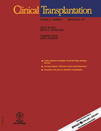Assessment of nutritional status of patients waiting for liver transplantation
Abstract
Ferreira LG, Anastácio LR, Lima AS, Correia MITD. Assessment of nutritional status of patients waiting for liver transplantation. Clin Transplant 2011: 25: 248–254. © 2010 John Wiley & Sons A/S.
Abstract: Patients with advanced liver disease have several risk factors to develop nutritional deficiencies. Accurate nutritional assessment is a real challenge because many of the traditionally measured parameters of nutritional status vary with severity of liver disease independently of nutritional status. The objective of this study was to compare different tools used to assess the nutritional status of patients waiting for a liver transplant. Patients were nutritionally assessed by SGA, anthropometry, handgrip dynamometry and biochemical tests. Clinical variables were cross analyzed with the nutritional assessment methods. There were 159 patients followed. Malnutrition ranged from 6.3% to 80.8% according to the different methods used. Agreement among all the methods was low (K < 0.26). Malnutrition prevalence according to different nutritional assessment tools did not differ among this group of patients in relation to the etiology of liver disease (p > 0.05) but increased with the more advanced stages of disease according to the Child-Pugh score. Only SGA showed significant relationships with clinical variables (Child-Pugh scores, p < 0.05; presence of ascites and/or edema, p < 0.01; and encephalopathy, p < 0.01). The various methods used showed great variability of results, lack agreement among them, and only SGA showed correlation with the progression of liver disease.




